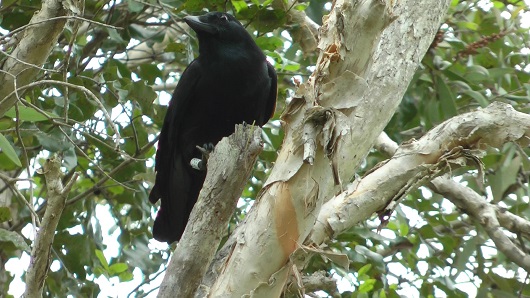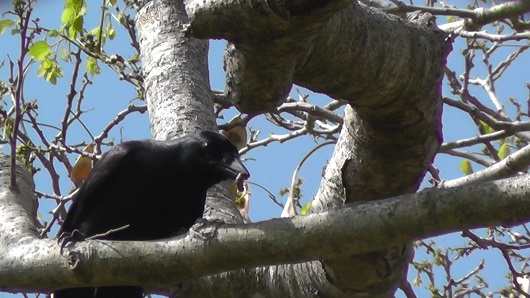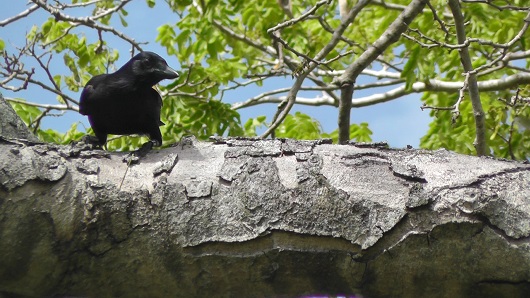Careful crows watch their tools
Researchers at the University of St Andrews have discovered that crows, like humans, store their tools when they don’t need them. The study published today (Wednesday 20 May, 2015) in the Proceedings of the Royal Society is the first to examine how non-human animals avoid accidental tool loss.
New Caledonian crows are famous for using stick tools to extract insects from tree holes and other hiding places. Crows hold tools in their bill when foraging, but need to put them down to eat their prey. “We were really excited when we saw crows in our study site carefully placing tools under their feet, to use them again later” says Barbara Klump, lead author of the study.

In experiments with wild-caught birds, the researchers discovered that crows look after their tools more carefully when foraging at height than on the ground. Ms Klump explained:
“This makes perfect sense because the higher up you are, the more challenging it would be to recover a tool. In fact, wild crows seem to get really upset when they accidentally drop their tools!”

Humans use many different tools every day, and are very good at keeping them safe for later use. Dr Christian Rutz, team leader and one of the study’s co-authors, said:
“When you put a treasured pen in a pen holder, you know where it is, and can quickly find it again. It turns out that crows do exactly the same, sometimes storing their tools in tree holes or behind bark.”
The crows were extremely good at keeping track of their tools, remembering where they had put them, and reusing them again to extract more meals shortly after.
This tool ‘safekeeping’ may be very important, as it means crows don’t have to repeatedly manufacture new tools and can spend more time on the critical business of finding food. Exactly how long wild crows use individual tools for, and how far into the future they can plan, remains to be explored.

Notes to news editors
The article “Context-dependent ‘safekeeping’ of foraging tools in New Caledonian crows”, by Barbara Klump, Jessica van der Wal, James St Clair and Christian Rutz, is available online from 08:01 (BST) on Wednesday 20 May 2015 at: http://rspb.royalsocietypublishing.org
The study was funded by the UK’s Biotechnology and Biological Sciences Research Council (BBSRC).
Images of crows are available from the Press Office on request. Contact 01334 462 530
New Caledonian crows live on the tropical archipelago of New Caledonia in the South Pacific, where all fieldwork for this study was conducted. They are well known for their sophisticated tool behaviour, including the manufacture of hooked stick tools (as studied here).
Crows for this study were held in field aviaries for the brief duration of their experimental trials, before being released back into the wild.
Several animal species use tools for foraging and a few of them have been reported to re-use and even transport their tools. This study is the first, however, to investigate what animals do with their tools between meals.
The two corresponding authors are available for interviews.
Ms Barbara Klump [email protected] +44 (0)7771 440 514
Dr Christian Rutz [email protected] +44 (0)7792 851 538
Category Research